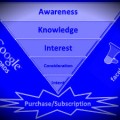It’s the beginning of the year. You are most likely hard at work planning your marketing for the next few months. Trying to see where you will be allocating your budgets. You are now convinced, probably because you read it over a hundred times in the last few years, that digital marketing needs to be an important part of your plan.
While planning, you should be aware of the following three hurdles that, if not cleared properly, will undoubtedly impede the returns you are hoping to get from your investments in digital marketing.
Lack of knowledge
Let’s face it. Digital marketing is evolving so fast in the last few years that it’s almost impossible to keep up with all the new techniques, tools and applications out there. Raise your hand if you feel you know all that you need to know about web analytics, programmatic, social media platforms, mobile advertising, email promotion and all the rest of the digital marketing world? My hand is not up and I spend a large chunk of my time reading on these topics and helping my customers plan for and implement them. At this time and point, keeping up with what’s new seems like a race to a finish line that keeps being pushed further every time you look up.
Marketing is no longer a one person job, even in the smallest of companies. Every resource in the company needs to keep up with market information and contribute to the planning. That still doesn’t mean that you will have the digital marketing expertise internally to execute your plan. It will however allow you to have a better idea of the tactics that you can include in your plan.
It also means that it would be wise to accept that your plan will be a very short term one. Chances are a new application or tool will come out in the next month or so that will give you better returns than what is currently available and you will need to adjust your plan. It could also be that Facebook, LinkedIn, Instagram or another social platform retires or changes a feature that you were banking on.
Lack of strategy
Lack of strategy for your digital marketing or any other business management aspect is the best recipe to shoot yourself in the foot eventually. You can have the most beautiful website or presence on the web but if it’s not tied into a good strategy it’s akin to buying the most beautiful and powerful car on the lot and having no driver. It won’t get you very far.
Sparse resources combined to the massive amount of knowledge to acquire in digital marketing make it more efficient to narrow down which of the tools you want to focus on to start with.
Your strategy will enable you to identify goals and market segments you will need to prioritise. This information will point the way to the right digital marketing tools to achieve your goals. As an example if you are a small B to B software firm and your marketing strategy identifies opening a new niche market in a restrained geographic area, investing in an Adword campaign although useful, may not be where you will get your best returns. Investing in an email marketing application may however be where you need to focus. Your resources time will therefore be better spent finding and learning an email application rather than learning how to run an Adword campaign in the first part of the year.
Dark traffic and dark social
This hurdle is at a higher level. This one will impact even the most advanced companies using digital marketing tools.
Dark traffic and dark social, a subset of dark traffic, refer to all the traffic that enters your website or mobile application that analytic applications cannot identify. It usually is lumped up in the Direct channel category in Google Analytics. It can come from anonymous browsing (not all but some), email links or simply from mobile applications (mostly Facebook and Reddit) or websites that don’t collect or transmit information on their users or visitors source.
How big of an issue is it you ask? Well according to Radium One (Dec. 2014) study, it represents 59% of all digitally shared content in North America and an average of 69% worldwide. That is a pretty big chunk. (1)
In practice what it means is in order to get decent returns from many of the marketing digital tools that are based on segmenting analytics data (retargeting for one) you will need a significant amount of visible traffic to compensate for the dark one.
As with any good runner these hurdles should not discourage you from running the race. Hopefully knowing about them and planning accordingly will help you turn in a better time.
(1) Facebook’s mobile app is responsible for the largest part of this dark social traffic. Once analytics applications find a way to count this traffic the importance of dark social will go down dramatically. Increase in popularity of fully anonymous browsers such as Thor may however re-ignite the trend upwards.











